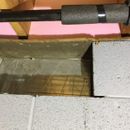Sill plate capillary break on block wall
I’m working on upgrading my 1979-built house to improve insulation in the basement and crawl space areas. There is a high water table here, and while I don’t have water flowing through the walls, I do have concern with water wicking up to the sill plate. My plan is to install rigid foam (polyiso in some areas, XPS in others) against the block in the basement, or over the “floor” membrane that will run up the walls in the crawl space areas. I plan to use spray foam to insulate and air seal the rim joist but my question is regarding the capillary break.
I do have a sill plate, not pressure treated though, but I don’t recognize the material that appears to have been used as a capillary break on top of the hollow block wall beneath the sill plate. The material looks similar to the asphalt/fiber material used in concrete expansion joints. Does anyone recognize it in the attached pic? Do you think it will serve as a sufficient capillary break to protect the sill plate? I’m trying to avoid inserting flashing but will if needed.
Bill
GBA Detail Library
A collection of one thousand construction details organized by climate and house part










Replies
The stuff looks like foil-faced MDF or dusty-dirty asphalted fiberboard sheathing. If it has a foil facer, the foil facer is decent capillary break. If it's asphalted fiberboard (and I think it is), it is absolutely NOT a capillary break. Asphalted fiberboard is moisture tolerant, but it wicks and retains moisture. It has fairly high vapor permeance and can thus dry reasonably quickly, but it doesn't offer much protection for the foundation sill from liquid or adsorbed moisture.
Jacking up the house a section at at time by ~1/4" to be able to slip in sheet EPDM under the foundation sill would be a reliable capillary break. That sounds a lot worse/riskier than it actually is. EPDM is less thermally conductive than metal flashing, which makes it somewhat preferable. In high termite risk zones copper flashing or copper clad plastic sill gasket would be better.
Using unfaced EPS instead of XPS or polyiso for the wall foam would offer more drying capacity for the CMU toward the intrior, not that it needs it if there's a good capillary break under the sill plate. At 2" thickness Type-II EPS is still well over 1-perm, whereas most XPS would be less than 0.7 perms @ 2". Most polyiso would be similarly low perm FAR lower if foil faced. The R-value of XPS falls over time, and will eventually settle in at the same performance of EPS of similar density (typically ~R4.2/inch at 1.3lbs per cubic foot or higher.)
I think you’re right about it being asphalted fiberboard. I’ve attached a pic of a little chunk of it I broke off from an interior wall — it has no foil backing, unfortunately. Looks like I’ll be needing to install a capillary break, I step I’d hoped to avoid but not a huge deal.
I’d been thinking of using some scrap stainless sheet (I have a good relationship with a metal fabricator I use commercially), but I hadn’t thought of the heat conduction aspect. Do you have any thoughts using a more rigid material than EPDM — to allow easier insertion under the sill — such as thin sheets of UHMW polyethylene?
Thanks for the info!
Bill
Any thickness of any density polyethylene beyond 6' mil would be an adequate capillary break, with far lower thermal conductivity than stainless steel. UHMW seems a bit like overkill, but sure.
That indeed looks like asphalted fiberboard.